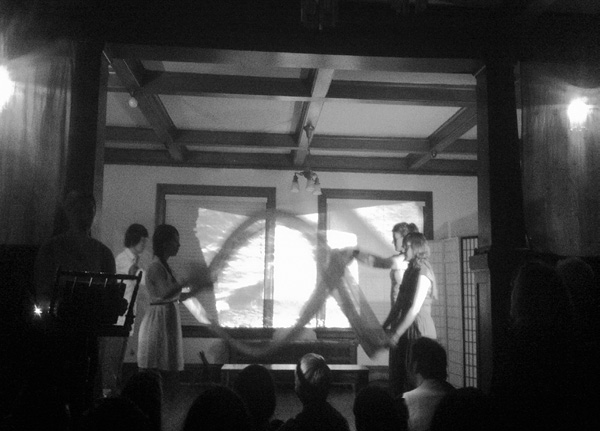
SWEET, A PLAY
first performed on March 10, 2012
Serena Chopra’s apartment, Denver, CO
performed twice in 2012
G.A.S.P. (GIRLS ASSEMBLING SOMETHING PERPETUAL)
Serena Chopra, HR Hegnauer, Andrea Rexilius, Erin Costello, Michele Battiste, Sommer Browning, Aaron Angello
Denver, CO
116635273s116635273e116635273r116635273e116635273n116635273a116635273.116635273r116635273.116635273c116635273h116635273o116635273p116635273r116635273a116635273@116635273g116635273m116635273a116635273i116635273l116635273.116635273c116635273o116635273m
SWEET, A PLAY
G.A.S.P. (GIRLS ASSEMBLING SOMETHING PERPETUAL)
“Sweet, a Play” was created as a poetic/performative articulation of Leslie Scalapino’s text of the same name. Combining elements of the sparse and often absent stage direction with dance, improvisation and interpretation, a poet’s theater of part abstraction, part sublimity, part accident and part gesture was made. The play itself comments on mob behaviors, protest, death and failed communication. Our underlying intent was not to highlight these politicized themes, but to find ways within theater, within a “play,” to parallel (not translate) radical, emotional elicitations of text, body and atmosphere. To speak as both mouth and limb simultaneously.
We turned a living room into a performance space. We hung thin, red curtains between the audience and the performers to designate a stage, moved furniture to one side of the room and threw throw pillows on the floor for audience seating. As per Scalapino’s stage directions, video footage of waves, shot by Hegnauer and Rexilius on Vashon Island, WA, was projected behind the performers. The stage remained bare except for five props: a bucket, a book, a bench, a podium and red and blue fabric used to evoke the movement of waves in the final scene. For the most part, costumes were white with distinct red accents constructed by each performer according to her character.
Scalapino does not assign speakers to the lines, rather, the play is a continuous text resembling a poem, so the performers choreographed the text through chance (drawing “characters” from a hat), and then designated certain stanzas or lines to the characters. “Characters” we created included: The Passerby, Someone Else, The Narrator, The Prisoner Pulling Weeds, and The Wanderer With a Book. Scalapino’s text allows for much interpretation, and with this freedom, we created a performance trajectory and narrative naturally, through discussion, collaboration, and rehearsals. The GASP performers are all writers with varying degrees of performance experience.